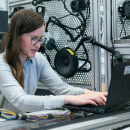
The Value of Astra Through Citizen Engagement
As discussed in a previous article, the Astra project places significant emphasis on evaluating its impact not only on scientific research but also on the broader community. While traditional cost-benefit analyses remain part of the process, Astra introduces an innovative, experimental approach aimed at answering a deceptively simple yet largely unexplored question: What is the value of such a scientific research project for Italian citizens?
To address this, the Astra research team is preparing a nationwide survey targeting a statistically representative sample of the Italian population, accounting for factors such as age, gender, geographic location, education, and income. Participants will be asked using recognized experimental methods, such as Willingness To Financially Participate (WTFP), as well as tailor-made approaches on how important Astra is to them as individuals and as members of a wider community.
The goal is to determine whether, and to what extent, the scientific research and technological innovations produced by Astra hold value in the eyes of the public. “We aim to collect primary data to estimate the so-called ‘existence value’ of research not its direct utility, but the perceived value of knowledge itself, regardless of any personal benefit” explains Adriana Pinate, head of the task Ensuring the Ethical Use of New Technologies within the project's third work package.
This concept, what economists refer to as non-use value, is complex and rarely measured empirically using economic incentives. Yet that is precisely what the Astra team intends to do: assess the public’s willingness to pay for basic research, even in the absence of direct involvement or tangible outcomes.
“People often ask how much research costs, but rarely how much it is worth to those who aren’t conducting it” Pinate adds, “And yet, simply knowing that projects like Astra exist that they develop technologies and generate knowledge with far-reaching impact can have intrinsic value, even for those with no direct ties to academia”.
The method employed is contingent valuation, a well-established tool in behavioral economics typically used to evaluate public goods, such as natural parks or protected rivers. In Astra’s case, however, the public good in question is scientific knowledge itself.
By analyzing the data gathered through this experiment, researchers will explore how perceptions of science’s value vary across different segments of the population. This demographic insight could also highlight which communities geographically and socially feel most connected to scientific advancement.
The experimental data will be nationally balanced and demographically representative. Moreover, its implications go beyond academia: the results are expected to feed into broader public discussions on the societal role of science. The findings will be published in leading international journals and made publicly available on the Astra website, in compliance with data privacy laws, to ensure transparency and credibility both for participants and the general public.
Through this impact assessment, the Astra team is not only evaluating outcomes, but also aiming to turn a technical exercise into a tool for civic engagement and public reflection. “Research doesn’t just produce results it can generate meaning, perspective, and future policy” Pinate concludes “Finding ways to communicate its value is, in itself, an act of innovation.”

